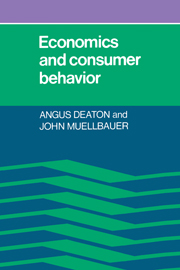Book contents
- Frontmatter
- Contents
- List of tables and figures
- Preface
- PART ONE CONSUMER DEMAND ANALYSIS
- PART TWO SEPARABILITY AND AGGREGATION
- 5 Restrictions on preferences
- 6 The theory of market demand
- PART THREE WELFARE AND CONSUMER BEHAVIOR
- PART FOUR EXTENSIONS AND APPLICATIONS
- References
- List of notation
- Name index
- Subject index
5 - Restrictions on preferences
Published online by Cambridge University Press: 05 June 2012
- Frontmatter
- Contents
- List of tables and figures
- Preface
- PART ONE CONSUMER DEMAND ANALYSIS
- PART TWO SEPARABILITY AND AGGREGATION
- 5 Restrictions on preferences
- 6 The theory of market demand
- PART THREE WELFARE AND CONSUMER BEHAVIOR
- PART FOUR EXTENSIONS AND APPLICATIONS
- References
- List of notation
- Name index
- Subject index
Summary
In Part I, we saw how the theory of choice, initially developed for application to the allocation of a fixed total expenditure over a number of goods, could be extended to deal with labor supply, the allocation of income between saving and consumption, and the purchase of durable goods. So far, we have looked at these extensions as separate problems, but in principle, each consumer has to deal with all of them simultaneously. At any given time, current assets and current and future income must be allocated over nondurable and durable goods for current and future periods, while for consumers who are free to do so, plans must be made for allocating time between work and leisure in the present and the future. There are also the complications of choosing types of real and financial assets as well as the problems of dealing with uncertainty. All of the parts of this allocation problem may interact: changes in future wage rates may alter retirement plans with important consequences for durable good purchases now; an anticipated increase in asset values three years hence may cause an elated investor to buy more of his favorite dinner, and so on. Such interactions pose formidable problems, not only for the consumer but also for the economist who attempts to describe consumer behavior. If making today's purchases requires knowledge of the price of bootlaces 30 years from now, daily living is close to impossible. Nor is there much hope of predicting behavior if all such possible interactions must be allowed for.
- Type
- Chapter
- Information
- Economics and Consumer Behavior , pp. 119 - 147Publisher: Cambridge University PressPrint publication year: 1980



